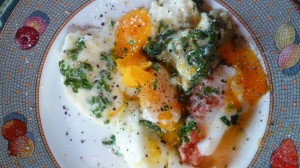Fast, fresh and local: Eggs en cocotte
There are many recipes online for eggs baked in ramekins and it seemed unnecessary to add yet another. But then I noticed an important variation that’s worth pointing out. Some baked eggs are just that: eggs cracked into a dish and cooked in an oven. They can be good, especially with embellishments. The thing is, unless those embellishments include lots of cream and butter, the intense heat of an oven can make the outside of the egg rather tough and dry. To me, what’s so wonderful about ‘oeufs en cocotte’ is their creamy smoothness. By placing the filled ramekins in a water bath — a pan with about an inch of simmering water — you surround them with gentle heat and cook the eggs slowly, evenly. The result is something delicious and elegant for very little effort.
When I first made eggs en cocotte, I turned to that beloved duo, Jacques and Julia. Jacques Pepin actually makes his oeufs en cocotte entirely on the stove, simmering the ramekins in a water bath, then putting the whole shebang under cover for the last few minutes. His basic recipe is similar to Julia Child’s but I like that she starts her eggs on the stove and finishes them in the oven. The unattended oven time, about six or seven minutes, is just enough for me to assemble a salad or finish setting the table. (If you’ve never seen her egg episode from the 1960’s series, The French Chef, it’s a delightful way to spend about 25 minutes.)
Preheat your oven to 375 degrees. Make a bain-marie or water bath: fill a baking pan with water to about 1 inch and set it on the stove to simmer over medium heat. Butter one or several ramekins or mini souffle cups, 6 oz. size, with about 1 tsp. of butter. (Note: the pan should be big enough that there’s space between the ramekins for water to flow.) Usually, I just put the pat of butter in each cup and let it melt in the simmering pan, then swirl the melted butter to cover the bottoms of each cup. Break a large egg (or two smaller ones) into each ramekin, being careful not to break the yolks. Drizzle a tablespoon of heavy cream over each egg, sprinkle a pinch of kosher salt on the whites (so you don’t speckle the yolks) and give them a fresh grinding of pepper. At this point, you might add any of the following: minced fresh herbs such as dill, tarragon or chives; grated hard cheese such as gruyere or aged gouda; marinara sauce or spicy salsa.
Place the prepared ramekins in the simmering water bath and allow them to begin cooking. Within a minute or two, you’ll see a film start to form around the edges, which is your clue to transfer the pan to your preheated oven. Check them at about six minutes; they should be set but still jiggle slightly and you may need to put them back for another minute. Remember, they’ll continue to cook in the hot water bath after you take the pan from the oven, so lift the ramekins from the water bath when they’re ready. You want the whites well set but the yolks still runny-to-soft.

Cooked creamed spinach and shallots were added to the far right cup after baking. Creamed minced mushrooms would also be a nice addition to the cooked eggs. The spinach and herbs came from Rabbit Fields Farm, the cheese from Samish Bay, the cream, from Twin Brooks Creamery. And the butter: home made, using Twin Brooks cream.

